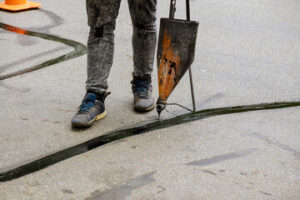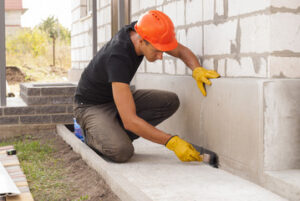Whether you own or manage a commercial or industrial property with asphalt parking lots and access driveways, seal coating is an integral part of your pavement maintenance routine.

It strengthens a paved surface by replenishing the degraded petroleum binder and blocking harmful elements and oxidizing substances that cause brittle pavement. It also helps the paving look brand-new. Visit https://www.rochesternysealcoating.com to learn more.
Asphalt pavement needs protection to prevent damage from weather and environmental wear-and-tear. Seal coating is an economical way to protect your paved surface. It also helps to fill in cracks and repair potholes so you can avoid costly asphalt resurfacing and reconstruction.
A properly applied and maintained asphalt seal coat keeps a paved surface in good condition and adds curb appeal to your property. It protects the asphalt from damage caused by oxidation, water, oil and chemicals. Sealcoating also protects the underlying base from the pressure of automobile traffic, which causes it to degrade and weaken over time.
The best time to sealcoat a parking lot or driveway is spring, as the temperatures are ideal for the sealant to cure. The paved area must be free of debris, dirt and oils before the application of the seal coat, which can be done by spraying or using a squeegee. The process is quick and efficient, but it is important to hire a professional for the job. Workers should be trained on how to use the equipment and be aware of the dangers that can occur when working with coal tar, petroleum products and other toxic materials.
A seal coat restores that fresh black look to asphalt, preventing it from becoming washed out and grey. It also gives faded asphalt a new appearance and improves the overall quality of your pavement.
Prevents Water from Penetrating
Sealcoating creates a thick protective layer that acts as a shell to shield asphalt surfaces from harmful elements. It is especially effective against water penetration, which is a major cause of damage to asphalt pavements. Water can seep into untreated asphalt and cause cracks that widen over time. It can also soak into the base material and cause erosion. Sealcoating prevents this penetration by blocking existing channels.
While pavement deterioration is caused by many factors, one of the most common is the sun’s ultraviolet (UV) rays. The UV rays can dry out and harden asphalt pavements, leading to cracking and fading. Regular sealcoating can significantly reduce the speed of this process and prolong the life of your asphalt surface.
Aside from its beautiful dark black color that enhances the look of new and old asphalt, seal coating also helps hide smaller cracks and imperfections. However, larger cracks should be repaired before sealcoating.
Prevents UV Rays from Penetrating
Asphalt is an economical and durable material for parking lots, but it’s not impervious to damage. The sun’s UV rays can cause oxidation in asphalt surfaces, which leads to brittleness and cracking. Sealcoating acts as a barrier to protect the asphalt surface from harmful UV rays and other environmental factors.
The ultraviolet rays in sunlight combine with oxygen to break down the asphalt’s binding chemicals. This deterioration wears away the surface of the asphalt and weakens the sub base beneath it. A regular application of a sealcoat prevents this from happening, as the sealant blocks out harmful UV rays and keeps the asphalt flexible.
When an asphalt parking lot or driveway is not sealed, the voids and cracks in the surface allow water, oil, gas and other chemicals to penetrate into the pavement and cause damage. Sealcoating forms a layer that seals off the voids and cracks in the pavement, reducing moisture penetration. This reduces the likelihood of cracking and deterioration caused by freezing and thawing during winter months.
Sealcoating also helps protect your parking lot or driveway from vehicle fluid leaks, which can etch and stain the asphalt. The coal tar emulsion in the sealer naturally resists oil and gasoline spills, and will minimize the amount of damage these leaks can do to your pavement. This is a cost-effective way to extend the life of your asphalt and improve its appearance.
Prevents Oil and Grease from Penetrating
Sealcoating protects your asphalt pavement from oil, grease and chemical spills. These liquids will slowly eat away at the asphalt, but they won’t be able to penetrate the protective layer of the sealcoat. This prevents them from damaging the underlying concrete or causing any sort of staining to the paved area.
Coal tar emulsion sealcoats are also effective at stopping oil, jet fuel and chemicals from seeping into the underlying asphalt surface. They will keep these types of chemicals from corroding the concrete and they’ll also help to restore the dark appearance that’s often lost over time.
Additives – Adding the right additives to your sealcoating mix is important as they boost specific properties like cold temperature flexibility, toughness, adhesion, fuel and chemical resistance etc. The use of too much water or sand in the mix can significantly reduce these properties and compromise the performance and durability of the sealcoat.
The addition of an additive based on acrylonitrile/butadiene (NBR) polymers will rubberize the sealcoating and improve its overall resistance to oil, fats, grease, de-icing salts, hydraulic fluids, aromatic fuels etc. It will also help to improve the tensile strength, reduce power steering marks and scuffing as well as speed up drying time.
These types of additives are ideal for use in parking lots and other high traffic areas. They will also stop the deterioration of aged aggregate and provide it with a more durable and uniform appearance.
Prevents Chemicals from Penetrating
While it might not be in the spotlight, seal coating is a key element of safe roads. It’s like bestowing the road with a shield that guards it from various forms of damage. Without it, roads are more susceptible to cracks and deterioration, which in turn lead to unsafe travels and costly repair jobs. With it, roads remain comfortable and secure for years to come.
Asphalt surfaces are constantly exposed to chemical spills and fluids from cars, including oil, transmission fluid, antifreeze, brake fluid, and other chemicals. These corrosive substances can soften and break down asphalt, making it impossible for the road to support the weight of vehicles. With sealcoating, these chemical substances are prevented from penetrating the asphalt surface.
The seal coat is made from a special blend of refined coal tar emulsions and fillers. The mix also contains additives to improve its performance, such as speed of drying, altering sand suspension, improving water repellency, increasing flexibility, and adding resistance to salts and other chemicals. The mixture is then applied evenly to the asphalt surface using brush applicators, spray applicators, or hand squeegees. It is then smoothed and leveled to ensure that the seal coat is distributed evenly across the asphalt surface.
Prevents Frozen Roadways
Asphalt is susceptible to water damage if it’s not sealed. Moisture can seep into small cracks and then freeze when it gets cold. This cycle of freezing and thawing stresses the asphalt, making it more vulnerable to damage. Sealcoating prevents moisture from entering the cracks, preventing them from becoming bigger problems down the road.
Sealcoating also prevents the damage that can be caused by salts and de-icing chemicals. These materials eat away at the surface of a driveway or parking lot, and if they are not removed promptly, they can cause potholes that will be expensive to repair. By forming a protective barrier, seal coating protects the asphalt from these harmful substances and helps keep it strong and stable.
A well-maintained asphalt driveway or parking lot adds value to your home, and it also makes the property more appealing for potential buyers or tenants. By having your asphalt seal coated regularly, you can ensure that it will last longer and look better.
To get the best results from your asphalt sealcoating project, it’s important to choose a professional company that uses quality products. The right equipment can make the difference between a good job and a bad one. The right equipment should include an oil sprayer used mainly for filling smaller cracks in the asphalt and a hot-pour crack filler that melts and reseals the asphalt. It’s also important to use a hose that has enough pressure for the project at hand.

